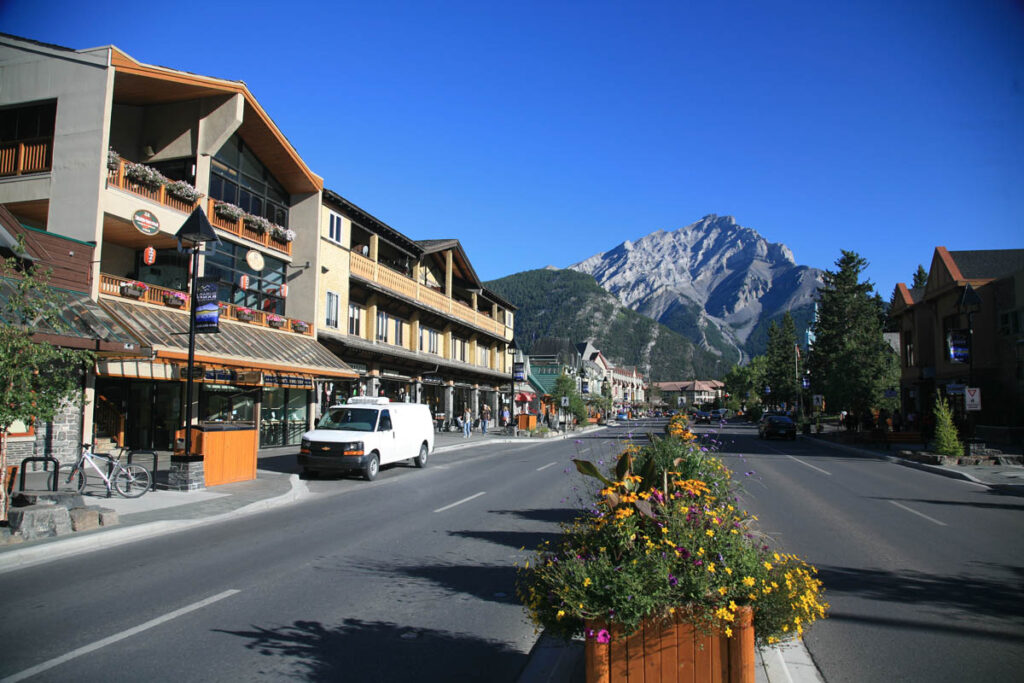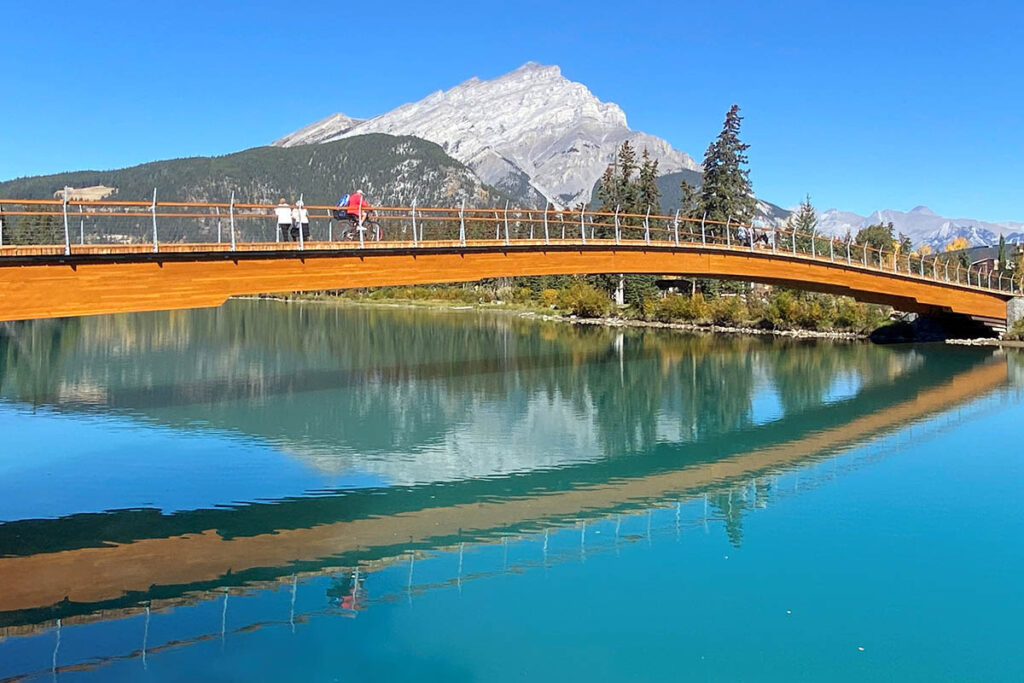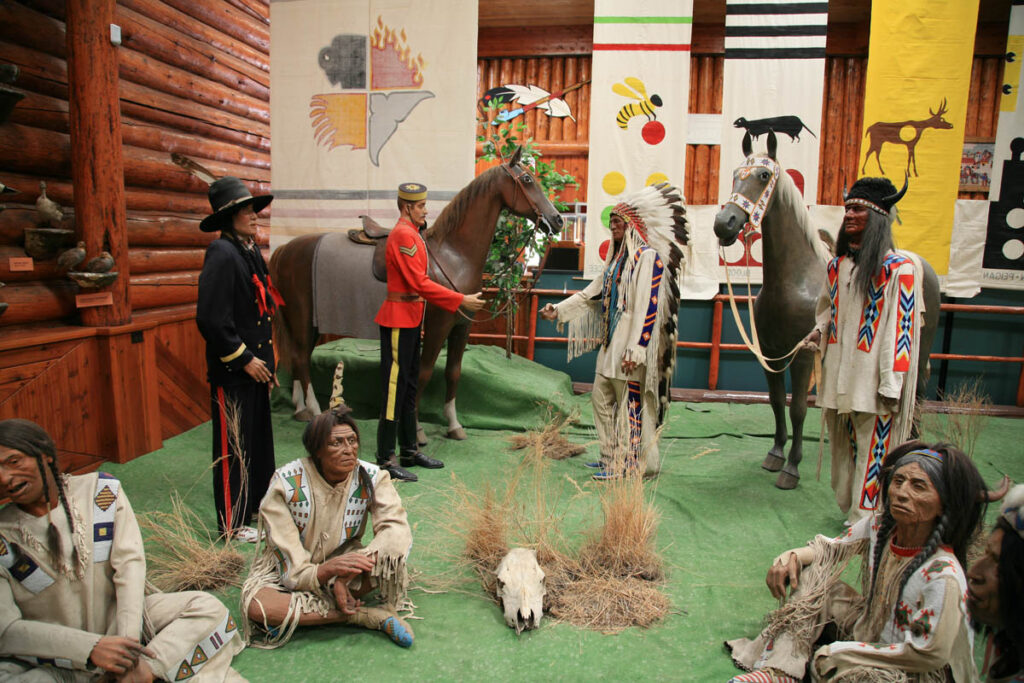Town of Banff
Many visitors planning a trip to the national park don’t realize that the town of Banff is a bustling commercial centre. The town’s location is magnificent. It is spread out along the Bow River, extending to the lower slopes of Sulphur Mountain to the south and Tunnel Mountain to the east. In one direction is the towering face of Mount Rundle, and in the other, framed by the buildings along Banff Avenue, is Cascade Mountain. Hotels and motels line the north end of Banff Avenue, while a profusion of shops, boutiques, cafes, and restaurants hugs the south end. Also at the south end, just over the Bow River, is the Park Administration Building. Here the road forks—to the right is the historic Cave and Basin Hot Springs, to the left the Fairmont Banff Springs and Banff Gondola. Some people are happy walking along the crowded streets or shopping in a unique setting; those more interested in some peace and quiet can easily slip into pristine wilderness just a five-minute walk from town.
If you’re interested in the history of Banff, we recommend A Guide to the History of Banff National Park by Summerthought Publishing, which details museums, historic sites, and heritage properties throughout the national park. It’s available through the publisher and at the Whyte Museum Bookshop.

Banff Avenue.
Downtown Sights
Although displays of stuffed animals are not usually associated with national parks, the downtown BANFF PARK MUSEUM (93 Banff Avenue, 403/762 1558) provides an insight into the park’s early history. Visitors during the Victorian era were eager to see the park’s animals without actually having to venture into the bush. A lack of roads and scarcity of large game resulting from hunting meant that the best places to see animals, stuffed or otherwise, were the game paddock, the zoo, and this museum, which was built in 1903. In its early years, the Banff Zoo and Aviary occupied the grounds behind the museum. The zoo kept more than 60 species of animals, including a polar bear. The museum itself was built before the park had electricity, hence the railroad pagoda design using skylights on all levels. As times changed, the museum was considered outdated; plans for its demolition were put forward in the 1950s. Fortunately, the museum was spared and later restored for the park’s 100th anniversary in 1985. While the exhibits still provide visitors with an insight into the intricate workings of various park ecosystems, they are also an interesting link to the park’s past. The museum also has a Discovery Room, where touching the displays is encouraged, and a reading room is stocked with natural history books.
The Whyte Foundation was established in the mid-1950s by local artists Peter and Catharine Whyte to help preserve artistic and historical material relating to the Canadian Rockies. The WHYTE MUSEUM OF THE CANADIAN ROCKIES (111 Bear Street, 403/762 2291) opened in 1968 and has continued to grow ever since. It now houses the world’s largest collection of Canadian Rockies literature and art. Included in the archives are more than 4,000 volumes, oral tapes of early pioneers and outfitters, antique postcards, old cameras, manuscripts, and a large photography collection. The highlight is the photography of Byron Harmon, whose black-and-white studies of mountain geography have shown people around the world the beauty of the Canadian Rockies. The downstairs gallery features changing art exhibitions. The museum also houses the library and archives of the Alpine Club of Canada. On the grounds are several heritage homes and cabins formerly occupied by local pioneers.
South Side of the Bow River
Linking downtown to the south side of town are two PEDESTRIAN BRIDGES across the Bow River. The Muskrat Street bridge dates to 2013 and the Central Park bridge opened in 2022. From both bridges, views extend west (upstream) up the Bow Valley and east to Tunnel Mountain. In addition to the views, the bridges have a practical purpose – linking downtown to south-side attractions such as the Fairmont Banff Springs and Bow Falls (see below).

Cascade Mountain from one of two pedestrian bridges.
Across the river from downtown, CASCADE GARDENS (always open, free) offers a commanding view along Banff Avenue and of Cascade Mountain. The gardens are immaculately manicured, making for enjoyable strolling on a sunny day. The stone edifice in the centre of the garden is the Park Administration Building, which dates to 1936. It replaced a private spa and hospital operated by one of the park’s earliest entrepreneurs, Dr. R. G. Brett. Known as Brett’s Sanatorium, the original 1886 structure was built to accommodate guests drawn to Banff by the claimed healing qualities of the hot springs’ water.
Looking like a stockade, the BUFFALO NATIONS LUXTON MUSEUM (1 Birch Avenue, 403/762 2388) overlooks the Bow River across from Central Park. It is dedicated to the heritage of the First Nations who once inhabited the Canadian Rockies and adjacent prairies. The museum was developed by prominent local resident Norman Luxton in the early 1900s. At that time it was within the Indian Trading Post, an adjacent gift shop that still stands. The museum contains memorabilia from Luxton’s lifelong relationship with the Stoney, including an elaborately decorated tepee, hunting equipment, arrowheads dating back 4,000 years, stuffed animals, original artwork, peace pipes, and traditional clothing. Various aspects of native culture—such as ceremonial gatherings, living in a tepee, and weaving—are also displayed. The adjacent BANFF TRADING POST is one of Banff’s more unique gift shops and is definitely worth a browse.

Buffalo Nations Luxton Museum.
At the end of Cave Avenue, the CAVE AND BASIN NATIONAL HISTORIC SITE (Cave Avenue, 403/762 1566) is the birthplace of Banff National Park and of the Canadian National Parks system. Here in 1883, three men employed by the CPR stumbled on the hot springs now known as the Cave and Basin. Bathhouses were installed in 1887, and bathers paid $0.10 for a swim. The pools were eventually lined with concrete, and additions were built onto the original structures. Although the pools are now closed for swimming, the centre is still one of Banff’s most popular attractions. A narrow tunnel winds into the dimly lit cave, and short trails lead from the centre to the cave entrance and through a unique environment created by the hot water from the springs. Interpretive tours run three times daily in summer. Also see our Cave and Basin page.
The BANFF UPPER HOT SPRINGS (Mountain Avenue, 403/762 1515), high above the town of Banff, were first developed in 1901. The present building was completed in 1935, with extensive renovations made in 1996. Water flows out of the bedrock at 47°C (116.6°F) and is cooled to 40°C (104°F) in the main pool. Once considered for privatization, the springs are still run by Parks Canada and are popular throughout the year.
The easiest way to get high above town without breaking a sweat is on the BANFF GONDOLA (Mountain Avenue, 403/762-2523). The modern four-person cars rise 700 metres (2,300 feet) in eight minutes to the summit of 2,285-metre (7,500-foot) Sulphur Mountain. From the observation deck at the upper terminal, the breathtaking view includes the town, Bow Valley, Cascade Mountain, Lake Minnewanka, and the Fairholme Range. Bighorn sheep often hang around below the upper terminal. The short Vista Trail leads along a ridge to a restored weather observatory. Between 1903 and 1931, long before the gondola was built, Norman Sanson was the meteorological observer who collected data at the station. During this period, he made more than 1,000 ascents of Sulphur Mountain, all in the line of duty.
On a terrace above a bend in the Bow River is THE FAIRMONT BANFF SPRINGS (405 Spray Avenue, 403 762 2211), one of the largest, grandest, and most opulent mountain-resort hotels in the world. What better way to spend a rainy afternoon than to explore this turreted 20th-century castle, seeking out a writing desk overlooking one of the world’s most-photographed scenes and penning a long letter to the folks back home?
The hotel is a 15-minute walk southeast of town, either along Spray Avenue or via the trail along the south bank of the Bow River. Banff Transit buses leave Banff Avenue for the Springs twice an hour. Alternatively, horse-drawn buggies take passengers from the Trail Rider Store (132 Banff Ave., 403/762-4551) to the Banff Springs.
Small but spectacular BOW FALLS is below the Fairmont Banff Springs, only a short walk from downtown. The waterfall is the result of a dramatic change in the course of the Bow River brought about by glaciation. At one time the river flowed north of Tunnel Mountain and out of the mountains via the valley of Lake Minnewanka. As the glaciers retreated, they left terminal moraines, forming natural dams and changing the course of the river. Eventually the backed-up water found an outlet here between Tunnel Mountain and the northwest ridge of Mount Rundle. The falls are most spectacular in late spring when runoff from the winter snows fills every river and stream in the Bow Valley watershed.
To get there from town, cross the bridge at the south end of Banff Avenue, scramble down the grassy embankment to the left, and follow a pleasant trail along the Bow River to a point above the falls. This easy walk is one kilometre (0.6 mile); 20 minutes each way. By car, cross the bridge and follow Golf Course signs. From the falls a paved road crosses the Spray River and passes through the golf course.
On the lower slopes of Tunnel Mountain is the BANFF CENTRE (St Julien Road, 403/762 6100), whose surroundings provide inspiration as one of Canada’s leading centres for postgraduate students in a variety of disciplines, including Mountain Culture, Arts, and Leadership Development. The Banff Centre opened in the summer of 1933 as a theater school. Since then it has grown to become a prestigious institution attracting artists of many disciplines from throughout Canada. The Centre’s WALTER PHILLIPS GALLERY (403/762-6281) presents changing exhibits of visual arts from throughout the world.
